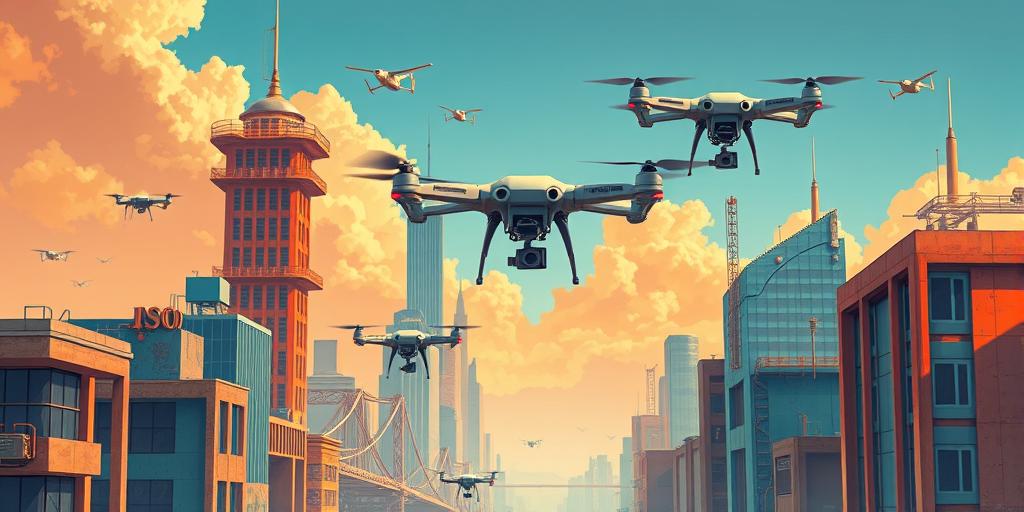Prepare for takeoff into the exhilarating world of autonomous drones! The future is closer than you think, and it’s buzzing with potential. From package delivery to search and rescue, autonomous drones are poised to revolutionize industries and our daily lives. But what exactly does this future hold? Buckle up, because this journey into the future of autonomous drone technology is going to be mind-blowing!
The Rise of the Machines: How Autonomous Drones Are Transforming Industries
Autonomous drones, also known as unmanned aerial vehicles (UAVs) or simply drones, are transforming a multitude of sectors. Their ability to operate independently, without human intervention, unlocks incredible opportunities. Imagine a world where package delivery is swift and silent, where infrastructure inspections are automated and safer, and where emergency response times are drastically reduced. That world is rapidly becoming a reality. This is due to several significant breakthroughs in AI, battery technology, and sensor capabilities. The enhanced capabilities of these autonomous systems are ushering in a new era of efficiency and innovation. These aerial robots are capable of performing tasks considered too dangerous, repetitive, or time-consuming for humans.
Agriculture: Precision Farming Takes Flight
Precision agriculture is one area experiencing a dramatic shift. Autonomous drones are now routinely used to monitor crop health, identify areas needing attention, and even apply pesticides and fertilizers with incredible accuracy. This reduces waste, optimizes resource allocation, and ultimately boosts yields. This targeted approach allows for minimizing environmental impact and maximizes the productivity of farmlands. The use of drones reduces the need for manual labor, saving time and money for farmers while allowing them to make data-driven decisions.
Infrastructure Inspection: A New Era of Safety and Efficiency
Inspecting bridges, power lines, and other infrastructure is often dangerous and time-consuming. Autonomous drones, equipped with high-resolution cameras and sensors, can now perform these inspections quickly and safely, identifying potential problems before they become major hazards. This proactive approach significantly reduces maintenance costs and minimizes risks to human inspectors. The ability to access hard-to-reach areas significantly improves the efficiency and safety of inspection processes, particularly for large-scale infrastructure projects.
Emergency Response: Saving Lives with Speed and Precision
In the aftermath of natural disasters or emergencies, autonomous drones are proving invaluable. They can rapidly assess damage, locate survivors, and deliver essential supplies to hard-to-reach areas, significantly improving response times and saving lives. The development of autonomous drone technology plays a crucial role in search and rescue operations, allowing responders to conduct swift and thorough searches, covering larger areas in shorter times.
Challenges and Concerns: Navigating the Future of Autonomous Flight
While the potential of autonomous drones is immense, several challenges need addressing. Ensuring safe and reliable operation is paramount. This includes developing robust collision-avoidance systems, addressing cybersecurity concerns, and establishing clear regulatory frameworks. These are major hurdles that must be overcome to ensure safe and responsible use of autonomous drone technology. Strict regulations will be crucial for managing airspace, preventing accidents, and securing privacy.
Regulatory Hurdles: Balancing Innovation with Safety
Governments worldwide are grappling with regulating the use of autonomous drones. Balancing the need for innovation with ensuring public safety is a complex task. Clear regulations are needed to define operating procedures, airspace management, and liability in case of accidents. These regulations are crucial not only for public safety but also for fostering trust and acceptance of drone technology.
Ethical Considerations: Privacy and Security Concerns
The use of autonomous drones raises ethical concerns about privacy and data security. These concerns necessitate careful consideration and the implementation of strong measures to safeguard individual privacy while fully utilizing the benefits of this technology. This necessitates ongoing dialogue among policymakers, technologists, and the public to develop ethical guidelines that ensure the responsible use of autonomous drones.
Technological Limitations: Pushing the Boundaries of Innovation
Despite significant advancements, autonomous drones still face technological limitations. Extending flight times, improving battery life, and enhancing navigation systems in challenging environments remain key areas for ongoing research and development. Technological advancements are essential to overcome obstacles such as unpredictable weather conditions and complex terrain, expanding the scope of autonomous drone applications.
The Future is Autonomous: A Glimpse into Tomorrow’s Skies
The future of autonomous drones is bright, promising a world of increased efficiency, improved safety, and unprecedented possibilities. As technology continues to advance and regulations evolve, we can expect to see even more innovative applications emerge. The ongoing development of advanced AI algorithms, sensor technologies, and communication systems will further enhance the capabilities and applications of autonomous drones, leading to breakthroughs in diverse fields. From delivery services to environmental monitoring, autonomous drones are poised to shape our world in extraordinary ways.
Ready to take flight with the future? Explore the amazing world of autonomous drone technology today! Click here to learn more!




